“911, what is your emergency?”
“We need help in Gates!” a caller screams in a 911 recording. “There’s a fire coming up in the neighborhood. It’s huge!”
On the night of Sept. 7, 2020, calls like this were streaming into 911 dispatchers and overwhelming local firefighting capabilities when Johne Martin woke up, stepped outside his house and saw absolute chaos surrounding him.
“The wind started whipping … the limbs started flying around, and I’m hearing trees break down,” he said. “And I looked down the street toward the Petersons’ place, and the wind blew a line down, and it caught things on fire below. It burned the Petersons’ place, too.”
He could see another fire burning in the distance that had already destroyed two homes, and there were lots of downed power lines.
“There was more than just the power line I’d seen blown down,” he said. “There was more up and down the roads.”
Martin quickly realized he had to leave — and fast. He hurried to grab what he could from his house. It wasn’t much. Some family photos, medications and a safe. The rest of his belongings burned. The Petersons had left their home earlier, “so, they didn’t even know that their house was gone,” Martin said.
People called in to 911 that night to report fires on electrical poles near their homes, fires in fields and fires on the side of the highway where they were trying to evacuate but were stopped by downed trees and power lines. They also reported various electrical explosions, flashes and arcing around power lines.

Gates residents reported seeing down power lines and fires along the side of the road as they were evacuating on Sept. 7, 2020.
Courtesy of Dave Ewing
Martin and his neighbors in Gates never received an evacuation notice — perhaps because the nearest known wildfire, the Beachie Creek Fire, was still more than 10 miles away when the first reports came in of power lines igniting fires in town.
“I had no idea it was going to come up so harsh,” Martin said. “Up in the [Columbia River] Gorge they shut off the power … and they didn’t here. Why? That’s what’s got me.”
The first explanation for what happened in Gates was that the Beachie Creek wildfire spread quickly in historic 50-75 mph winds and burned through the town.
But another theory has emerged to explain how Gates and neighboring towns caught fire that night, and it’s shared by more than 100 people like Martin who have joined class action lawsuits against the electric utility Pacific Power and its parent company, PacifiCorp.
The lawsuits argue the fires that overran their homes, schools, businesses and lives were ignited by the company’s electrified power lines, well before the Beachie Creek Fire reached town.
The plaintiffs say Pacific Power knew in advance that a historic wind storm could blow trees into power lines and start fires and it could have prevented the losses by shutting off power in Santiam Canyon communities.
Pacific Power declined to comment on what happened last year, citing the pending litigation, though court records show the company has denied many of the allegations. The fires are still under investigation, so there’s a limited amount of conclusive information available about how smaller power line ignitions affected the spread of the larger Beachie Creek wildfire that eventually moved through the Santiam Canyon.
OPB reviewed 911 calls and dispatch logs from that night, interviews with eyewitnesses and public documents. They reveal evidence supporting the argument that power lines played a significant role in spreading fire throughout Gates and made it far more difficult for firefighters to defend the town against the advancing Beachie Creek wildfire.
What role did power lines play?
After hearing about how his friend’s home had burned in Gates, Portland attorney Ralph Bloemers wanted to know more about the role power lines played in the Labor Day fires.
“So one of the main questions that needed to be figured out is, was there a wall of flame or fire moving through the community on Labor Day or were these local ignitions?” said Bloemers, the founder of an environmental law firm and someone with decades of experience working on wildfire-related issues.
Bloemers said he is not involved in the lawsuits against Pacific Power. He worked with an independent fire investigator and a filmmaker to document the events of Sept. 7, 2020. He requested public records, conducted interviews with more than a dozen eyewitnesses, and found multiple people who saw power lines sparking and starting fires that night.
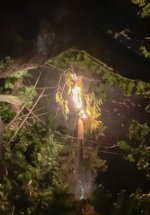
Mike Schaer, a firefighter with the Gates Rural Fire Protection District, captured this image of a fire on a power line near his home on Sept. 7, 2020.
Courtesy of Mike Schaer
“When I set out to hear what people’s stories were, to find out what they saw in their experiences on Labor Day, I knew there was a lot of people in the community that had seen things, and probably taken photos, taken videos,” Bloemers said.
He started contacting people in what he calls a “quest to make sure it doesn’t happen again.” Bloemers gave OPB his interviews, as well as videos, photos and documents he gathered. OPB has independently confirmed the accuracy of those materials, and has done additional reporting to provide key details of what happened that night.
Early warning of high winds
On Sept. 4, the Friday before Labor Day, the National Weather Service issued a warning for the following Monday urging “extreme caution with fire” in anticipation of “a strong east wind event.”
The service’s warnings grew more and more dire as Labor Day approached, with a “Red Flag Warning” of fire danger on Saturday afternoon, a “High Wind Warning” on Sunday and an “Extremely Critical Fire Weather Warning” on Sunday night predicting winds of up to 70 miles per hour.
News reports on Labor Day blasted the warnings amid dangerously dry drought conditions across the state.
“This is not the night to have a barbecue,” KGW chief meteorologist Matt Zaffino said in his Labor Day news report for the Portland television station. “This is more typical, to be honest with you, of a California-type situation where they get those strong winds. And it’s similar to what caused the Camp Fire that destroyed Paradise, California.”
Multiple power line fires reported
“911, in what city is your emergency?”
“We just had a transformer blow and we have a fire up in Lyons,” Linda Williams told the 911 dispatcher just before 7 p.m. in one of the first reports of a power line ignition. “It’s still burning.”
Williams was one of 13 callers who reached Metcom, the Marion County dispatch service, when they called 911 to report power line problems from 6-10 p.m. on Labor Day last year. Their reports included arcing power lines, smoldering branches on power lines, power line explosions and fires.
While some callers reported flashes they thought were lightning, the CoreLogic Weather Verification database has no reports of any lightning strikes in the area that night.
OPB confirmed three 911 calls about power line ignitions that resulted in fires. One of them was called in by a firefighter, Todd Meyer.
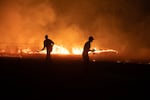
Firefighters at the incident command center for the Beachie Creek wildfire work to extinguish the blaze that started when high winds blew trees into power lines on Sept. 7, 2020. About a hundred members of the Beachie Creek firefighting team were forced to evacuate their camp at Gates School that night and relocate their command center to Salem.
Mark Turney / Courtesy of U.S. Forest Service
Meyer told dispatchers that trees had taken down power lines and started a fire at Gates School, where firefighters with the Incident Command Team 13 for the Beachie Creek wildfire were stationed.
“We’ve got brush fires going, lines down and a structure fire,” Meyer told the dispatcher. “It started with lines down. … Send a full response. I’m a firefighter.”
Dan Benjamin, assistant chief for the Gates Fire Department, remembers going from one fire to another after 9 p.m. that night. He said he had just helped extinguish a power line fire at a fellow firefighter’s house when he noticed a new fire on Potato Hill. Then, he was called to help with the fires ignited by power lines at Gates School, where about a hundred members of the Beachie Creek firefighting team were stationed.
“It was a fire camp, so we had lots of help from lots of firemen out there,” Benjamin said in a video interview that Bloemers conducted and recorded. “At that point we started getting other [calls] for fires west of the school. There were also electrical fires out on the highway.”
Firefighters were forced to evacuate immediately, and the incident command station was relocated from Gates School to Salem.
An incident report from Sept. 10 says fire managers with an interagency team had determined that at least 13 spot fires were started between the towns of Mehama and Detroit — a 28-mile stretch of the Santiam Canyon that includes Gates — during the peak of the Labor Day wind event.
In fact, the agencies temporarily renamed those fires the Santiam Fire, as noted in a Sept. 9 incident report, “acknowledging that the Beachie Creek Fire no longer was the main cause of rapid fire growth and was instead fed by a series of small fires largely caused by downed power lines and other ignition sources.”
Where was the Beachie Creek wildfire?
Mark Finney studies fire behavior at the Missoula Fire Sciences Laboratory. He said the heat maps generated by NASA’s GOES Satellite data are helpful in his work because they capture images of fire activity every 10 minutes.
Those maps show the Beachie Creek Fire spreading throughout the day. It was about 10 miles away from Gates at 9 p.m. when residents were reporting the fire on Potato Hill.
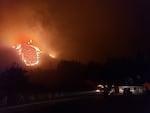
By the time Gates residents saw a large fire starting to spread on Potato Hill on Sept. 7, 2020, local firefighters had already been called to several power line fires in the area.
Courtesy of Shannon Hicks
Finney says it’s rare to see the embers from wildfires-set spot fires more than a few miles away, though the extreme winds that night would affect the distance the embers traveled from the Beachie Creek Fire.
Ten miles “really seems a long distance” given the size of the 500-acre Beachie Creek Fire going into the windstorm, Finney said.
Finney said the smaller fire ignitions from power lines also could have generated more fires in town.
“A dozen ignitions along some power line corridor all at once or in a short period in time is a big control difficulty and under high wind conditions, each of those then start torching trees and lofting embers,” he said. “The fires that are caused by any ignition source then generate a lot more fires and you can never really tell what fire is causing what to burn.”
Firefighters overwhelmed
A recording of local firefighter communication from the night of Labor Day documents a steady stream of calls dispatching fire engines and tenders to numerous reports of small fires and downed power lines. Eventually local agencies ran out of resources — including water.
The recording also captures discussion among Gates firefighters of their effort to “expedite” Pacific Power’s response to their request for help removing branches from power lines. But a dispatcher is heard saying the utility is “not giving any ETAs” for when that might happen.
As the night drew on, Benjamin said, the wind was spreading too much fire for his team to manage.
“We spent a short period of time dispatching different fire trucks to different calls and then team members started asking the question, ‘Where do we go?’ Because we could see this was getting bigger than what could be handled safely,” he said
By 10:30 p.m., records show firefighters were going door-to-door to issue evacuation notices as fire spread uncontrollably through the town of Gates. By midnight, the area had gone from having no evacuation notice to being under a level 3 “go now” evacuation order.
But evidence suggests Pacific Power still had not shut off its electricity in the area and didn’t do so well into the next day when Oregon State Police reported a downed power line arcing on a road. Several Gates residents including Billy Edge Sr. reported their power was still on late into the night and they were seeing explosions coming from nearby power lines.

As winds spread multiple fires through the town of Gates late into the night on Sept. 7, 2020, firefighters were overwhelmed and eventually had to evacuate themselves.
Courtesy of Dave Ewing
“I hear this boom and you see this bright light and probably 15 minutes later you can tell there’s a fire there,” Edge said. “About 20 minutes later another one did the same thing. … Shortly after that that’s when you start seeing the orange getting bigger through the trees”
Edge said he received no early evacuation notice. He lost his home in the fires. He’s one of many who have joined a class action lawsuit against Pacific Power and its parent company, PacifiCorp.
“In my heart I believe somebody still owes me a little bit of something to replace the things that me and my family lost that aren’t going to come through the insurance money,” Edge said.
Edge said he lost a precious photo and a video of his dad, who he’d only seen once in his life.
“I heard my dad sing on that tape,” he said. “I’m not happy about that. So if somebody’s responsible. So be it.”
Late in the night, Benjamin said his team decided it was time to evacuate the firefighters and their equipment.
“I knew we were overwhelmed,” Benjamin said. “And usually when we’re overwhelmed in Gates we can call for help, but I knew the whole system was overwhelmed not only here but clear to Salem because of this fire.”

Firefighters give directions during the Santiam Fire near Gates, Ore., Sept. 9, 2020.
Bradley W. Parks / OPB
Reports from the U.S. Forest Service estimated the Beachie Creek Fire was about 500 acres going into Labor Day, but it grew at a rate of nearly 3 acres per second, blowing up overnight to 131,000 acres.
Could the fires have been prevented?
A lot of people have been asking since September about the role power lines played in the destructive expansion of the Beachie Creek wildfire.
In October, Oregon Sens. Ron Wyden and Jeff Merkley called on the Oregon Department of Forestry and the U.S. Forest Service to analyze the role of power lines in the cause and spread of the Beachie Creek Fire.
“In a recent visit to the North Santiam Canyon, in which a number of Oregonians have lost their homes, vehicles, documents and family mementos to the Beachie Creek Fire, we were questioned repeatedly about the cause of the fire and how it could have been prevented,” the senators wrote in a letter to the agencies.

Roxane Emerson hugs her grandson after finding her home safe from the Santiam Fire near Gates, Ore., Sept. 9, 2020.
Bradley W. Parks / OPB
“We would like you to analyze what role the downed power lines played in the Beachie Creek fire, and, if so, could more have been done to prevent these power lines from starting fires in the windstorm? What role did downed power lines play in establishing new fires in the Canyon?” the letter continued.
According to Merkley’s office, the last update the senators received was a letter from the state and federal agencies in November that stated that the origins and impacts of the Beachie Creek Fire were still under investigation.
Comparing other utilities’ response to Pacific Power’s
Going into Labor Day last year, Pacific Power took a different approach from other utilities like Portland General Electric, which announced it would de-energize its power lines in anticipation of the extreme wind event.
Consumers Power Inc., which serves the areas surrounding Gates and Mill City, initiated its fire mitigation plans early and sent notices to its customers warning of possible power outages.
Allen Berreth, vice president of transmission and distribution operations for Pacific Power, said because of pending litigation he cannot discuss whether his company considered shutting off power in the Santiam Canyon last Labor Day.
But his company did have a plan for shutting off power for public safety during high winds, low humidity and dry vegetation, and told The Salem Journal-Statesman after the Labor Day fires last year it did not initiate that plan in Gates and surrounding communities because they weren’t in the company’s designated “Public Safety Power Shutoff” area.
Berreth said the company’s existing wildfire mitigation plans outline areas of high risk where the company is most likely to consider public safety power shutoffs to prevent fires because of historical weather patterns like wind and drought, population density and fire fuels.
The Santiam Canyon is not one of those high-risk areas, he said, but the company can de-energize its lines in any service area when conditions justify it.
“We really consider it to be a tool of last resort,” Berreth said, noting that de-energizing power lines can prevent firefighters from accessing water or communications in an emergency. “It is in the toolkit but we do recognize that de-energizing a community creates additional issues that have to be balanced out against the risk we’re trying to mitigate, which is the wildfire risk to the community.”
Berreth said his company has only done one public safety power shutoff ever, and it was in California.
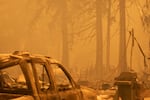
A person surveys the damage to a neighborhood burned in the Santiam Fire near Gates, Ore., Sept. 9, 2020.
Bradley W. Parks / OPB
The company’s existing wildfire mitigation plans for Oregon aren’t public documents, so it’s not possible to see exactly what those plans would have called for in September 2020. The state of Oregon is still working on new rules that will require utilities to file new public plans for wildfire mitigation.
Pacific Power doesn’t plan on expanding its list of high fire risk areas in its new wildfire mitigation plans for Oregon, Berreth said. But the company is planning to spend about $300 million to expand other wildfire mitigation capabilities over the next six years. That includes covering conductors so they won’t come in contact with trees, adding new technology that can de-energize lines faster, installing 100 additional weather stations and expanding its meteorology department to have in-house weather forecasting capabilities.
Bill Terry, director of operations at Consumers Power Inc., which serves the area surrounding Gates and Mill City as well as the town of Detroit, said that area is the highest risk fire area in their system.
“So we were keeping a close eye on that going into the storm Labor Day weekend,” he said.
Terry said his utility’s wildfire mitigation plan calls for action in response to “red flag” days, so the warnings issued in the days leading up to the storm triggered safety protocols that prepared the system to cut power to any lines that experience any problems.
“We set our system protection up basically to the highest level of sensitivity on Friday prior to the storm,” Terry said. “At the height of the windstorm on Monday, almost half of our system had the power turned off.”
As more and more alarms signaled problems with the power lines around 6 p.m. on Labor Day, he said, Consumers Power made the decision not to re-energize any of the lines until conditions improved.
‘The power company should have cut the power.’
Gates Mayor Ron Carmickle lost his home in the fires and only recently purchased an old manufactured home to replace it. He said almost everyone in town is involved in some kind of lawsuit against Pacific Power, himself included.

Ron Carmickle, mayor of Gates, says the town is still struggling with cleaning up and recovery following the 2020 Beachie Creek Fire.
Kristyna Wentz-Graff / OPB
“It’s obvious that there’s power line ignitions — many of them,” Carmickle said. “I got involved in the lawsuit because I was upset. For lack of a better term, I was pissed that this even happened. ... The power company should have cut the power.
There is precedent for the lawsuits against Pacific Power and its parent company, PacifiCorp. In 2019, California-based Pacific Gas & Electric agreed to a $13.5 billion settlement over power line mismanagement issues that fueled several fires including the 2018 Camp Fire in Paradise, California.
Bloemers said the more he learns about what happened in Gates on Labor Day, the more similarities he sees to the Camp Fire.
“A community was quickly overrun by local ignitions,” he said. “You had extreme weather, high winds, really low humidity, extreme drought, and so once you had ignitions, for the most part people just needed to get out, and they went from, you know, no warning, to just leaving with the shirts on their back.”
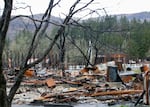
Remains of the devastation from the 2020 Beachie Creek Fire are still evident in the small town of Gates, Feb. 26, 2021.
Kristyna Wentz-Graff / OPB
Oregon lawmakers recently passed a $190 million bill aimed at preventing wildfires that calls on utilities to develop new wildfire mitigation plans.
Meanwhile, Gates residents are still mourning painful losses and chipping away at the challenges of rebuilding.
“The loss was enormous for everybody,” Carmickle said. “Even if you didn’t lose your home, there’s still loss.”
Carmickle said he hopes the lawsuits will shed some light on what actually happened in Gates on Labor Day last year.
“Most of the people I don’t think really do understand what happened here,” he said. “The legal system is where the ultimate decisions are going to be made.”